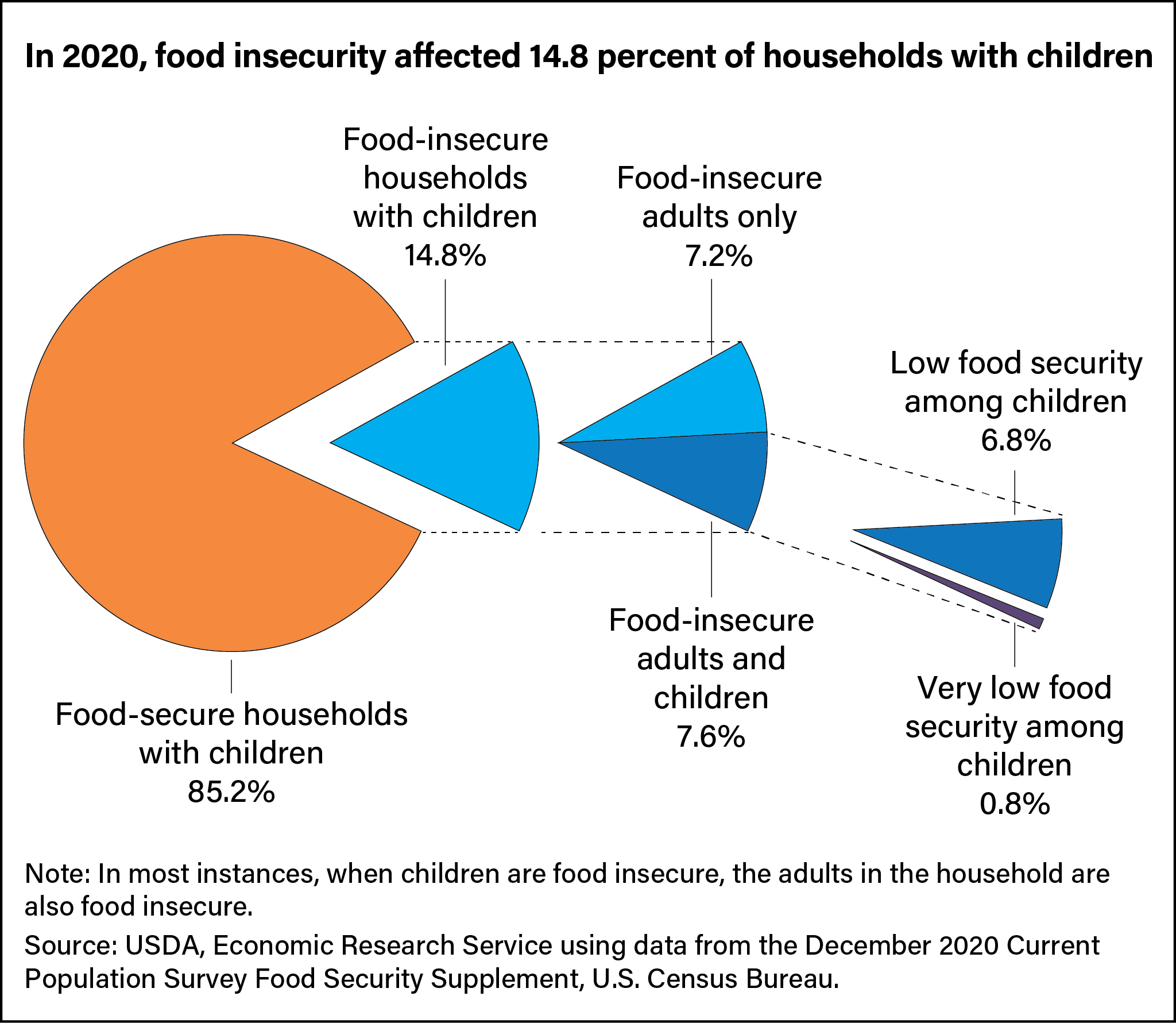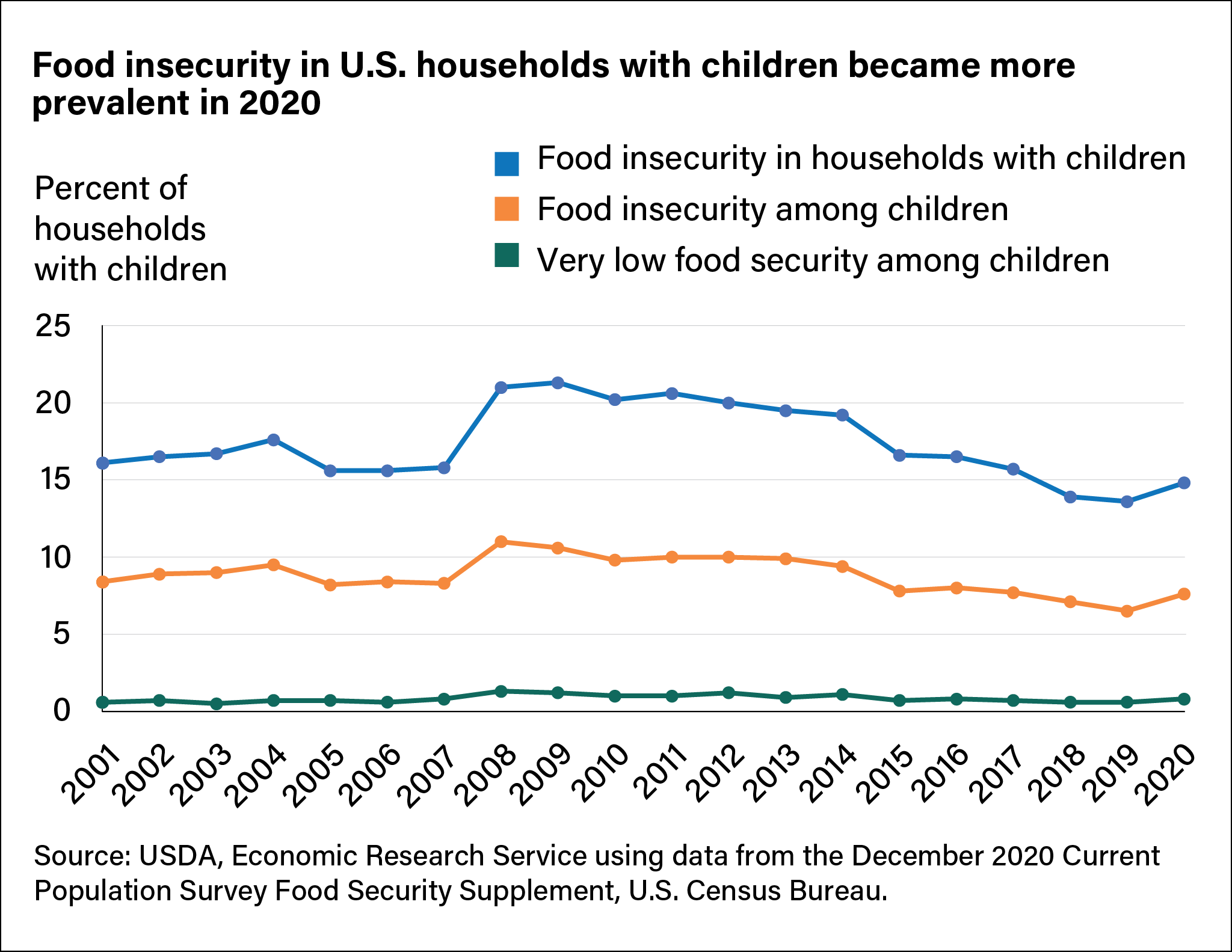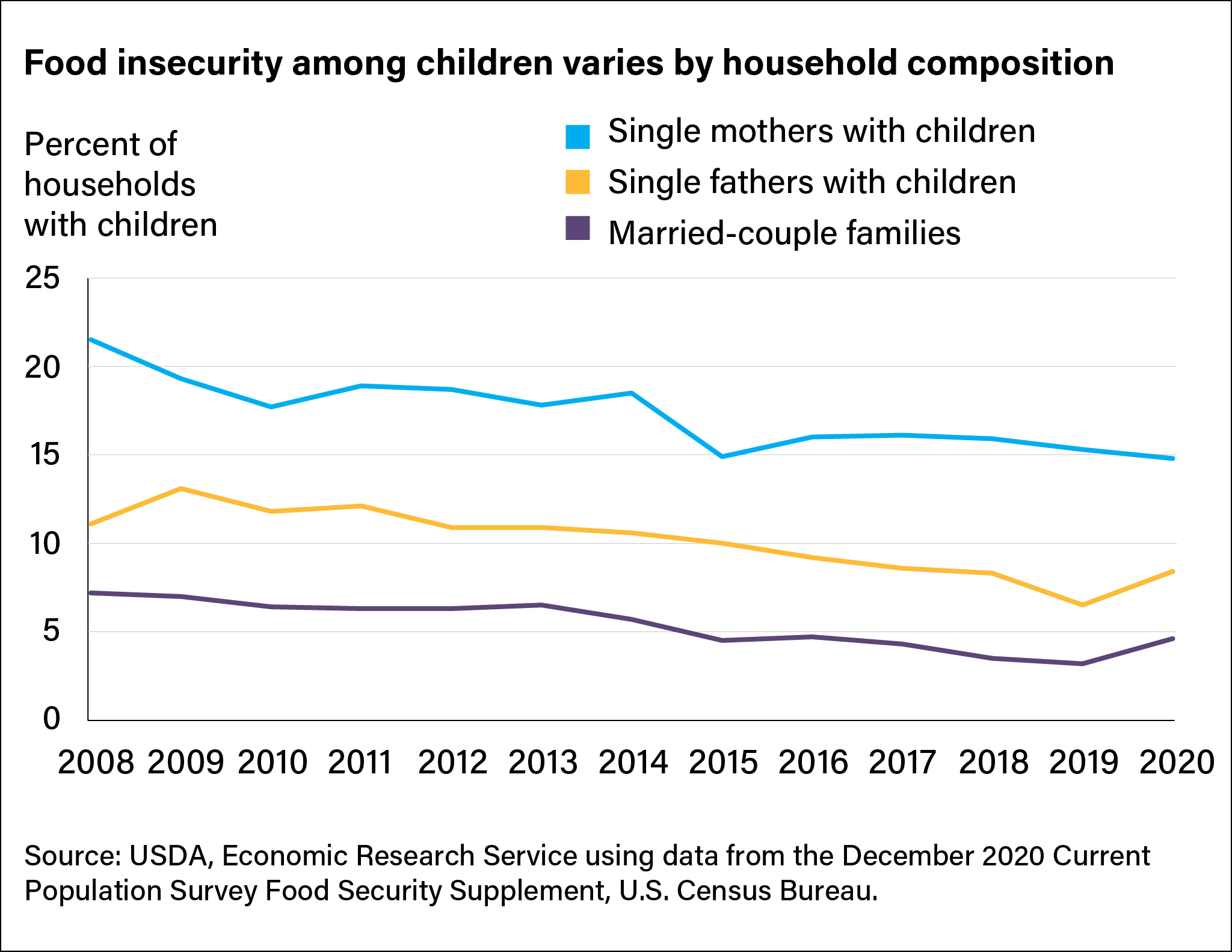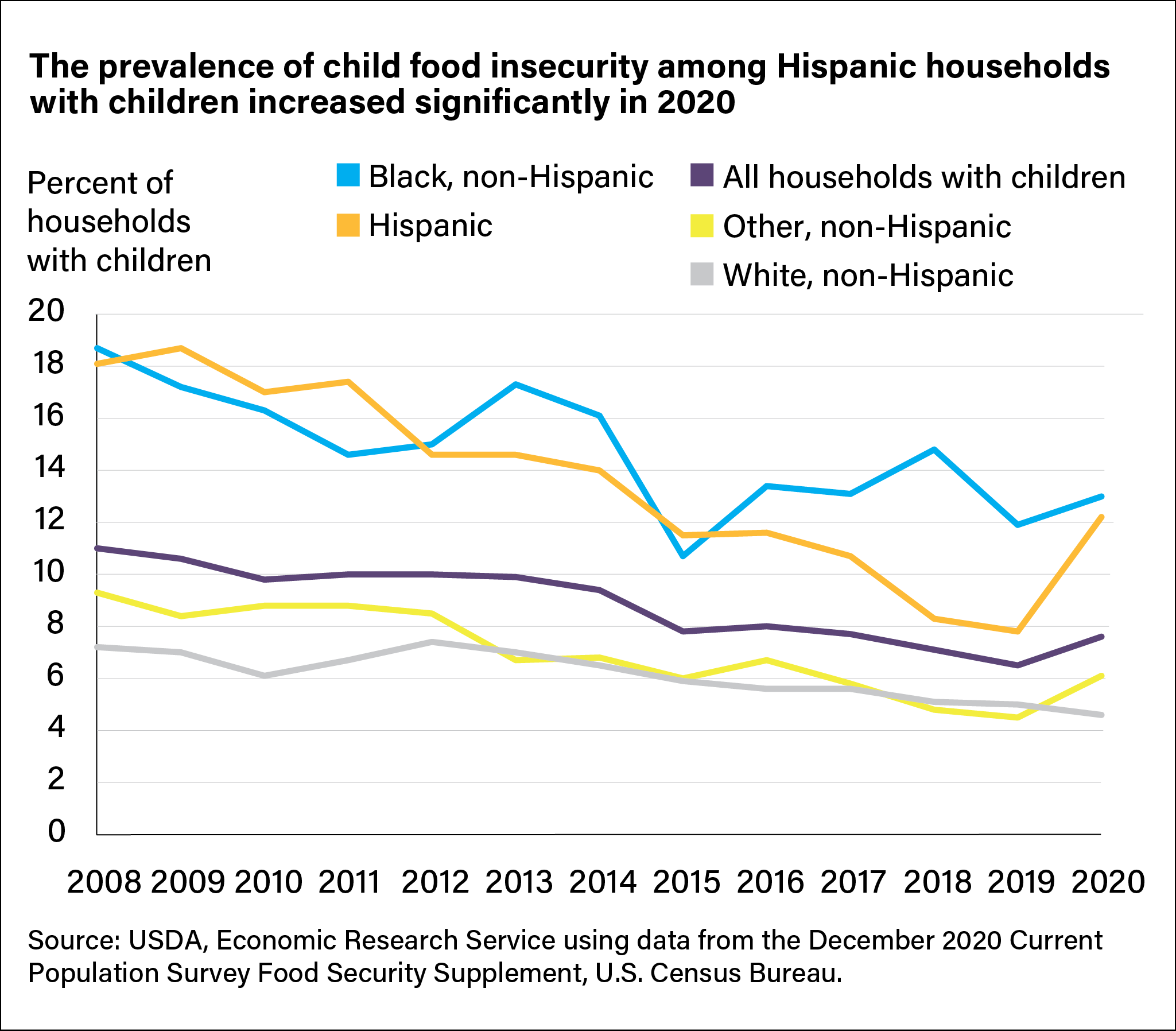
Food Insecurity for Households With Children Rose in 2020, Disrupting Decade-long Decline
- by Laura J. Hales and Alisha Coleman-Jensen
- 2/7/2022
Food security is defined as having access at all times to enough food for an active, healthy life. USDA reported that a lack of food security, or food insecurity, affected 10.5 percent of all U.S. households in 2020, unchanged from 2019. Households with children, however, experienced statistically significant increases in food insecurity during the Coronavirus (COVID-19) pandemic, even as overall food insecurity stayed the same. In 2020, 85.2 percent of households with children were food secure, while 14.8 percent were food-insecure, up from 13.6 percent in 2019.
Annual Survey Measures Food Insecurity in Households With Children
Data from the Current Population Survey Food Security Supplement, sponsored by the USDA, Economic Research Service (ERS), can be used to characterize food insecurity in U.S. households. Each year, ERS provides information on the prevalence and severity of food insecurity in an annual report, Household Food Security in the United States. ERS also publishes graphics, interactive data visualizations, and a recorded webinar that are available on the ERS website.
For households with children, food insecurity is measured for the household overall as well as for adults and children separately. One adult respondent per household answers a series of 18 survey items that ask about experiences and behaviors pertaining to food insecurity.
The food insecurity of households with children is measured by ERS in three ways:
- food insecurity in households with children (adults, or children, or both are food insecure)
- food insecurity among children
- very low food security among children
Households are classified as food insecure if, at some time during the year, they had difficulty providing enough food for all their members because of a lack of resources. In households with children, food insecurity indicates at least one person in the household experienced reductions in dietary quality or variety and, in some cases, disrupted eating patterns and reduced food intake. However, household food insecurity may be experienced differently across household members. Among the 14.8 percent of households with children that reported food insecurity in 2020, about half reported food insecurity for only the adults in the household.
The second measurement, food insecurity among children, means both adults and children experienced food insecurity. Caregivers in this category report that they were unable to provide adequate, nutritious food for their children at times.
Some households report a more severe range of food insecurity, in which children were hungry, skipped a meal, or did not eat for a whole day because there was not enough money for food. This situation is described as very low food security among children.
Food Insecurity Increased in All Measurement Categories for Households With Children in 2020
All three measurement categories of food insecurity for U.S. children experienced statistically significant increases in 2020. The percent of U.S. households with children that were food insecure reached 14.8 percent in 2020, or 5.6 million households, up from 13.6 percent in 2019. This increase in food insecurity in households with children was the first increase since 2011 and disrupted a decade-long downward trend.
The prevalence of food insecurity among children, in which both adults and children were food insecure, also increased significantly in 2020 to 7.6 percent. Food insecurity among children affected about 2.9 million households, which included about 6.1 million children, or about 8.4 percent of all U.S. children. The 2020 prevalence of food insecurity among children also interrupted a decline from a peak of 11.0 percent in 2008.
Finally, very low food security among children, the most severe range of food insecurity for children, increased significantly to 0.8 percent of households with children, up from 0.6 percent in 2019. Very low food security among children affected 322,000 households with children, which included about 584,000 children (0.8 percent of children).
Food Insecurity Varies by Household Composition
In 2020, married couples with children were the only household composition subgroup to experience a statistically significant increase in food insecurity among children. The prevalence of food insecurity among children in married-couple households with children increased to 4.6 percent from 3.2 percent in 2019. Despite this increase, the prevalence of food insecurity among children in married-couple households was still below the national average of food insecurity among children (7.6 percent in 2020).
Single mothers with children have historically had the highest levels of food insecurity compared to other household compositions. The change in the prevalence of food insecurity among children in single-mother households was not statistically different from 2019 to 2020. The prevalence of food insecurity among children in single-mother households with children in 2020 was 14.8 percent, which was significantly higher than for all households with children (7.6 percent). Single-mother households were more than three times as likely to experience food insecurity among children than married-couple households with children. Among single fathers with children, the change in food insecurity among children from 2019 to 2020 was not statistically significant.
Some Racial and Ethnic Groups Saw Increases in Food Insecurity in 2020
A household is classified by the race and ethnicity of the household reference person. The reference person in the survey is an adult in the household in whose name the housing unit is owned or rented. Households with children headed by Hispanic reference persons not only saw statistically significant increases in food insecurity among children in 2020 but also experienced a significantly higher prevalence of food insecurity than those for all households with children. The prevalence of food insecurity among children in Hispanic households increased to 12.2 percent in 2020 from 7.8 percent in 2019.
The prevalence of household food insecurity increased significantly from 2019 to 2020 for households with children with Black, non-Hispanic reference persons. However, the change in the measure of food insecurity among children for these households with Black, non-Hispanic reference persons from 2019 to 2020 was not statistically significant. In 2020, food insecurity among children affected 13.0 percent of these households. The prevalence of food insecurity among children in Black, non-Hispanic households has, like single mother households, been historically higher than the prevalence for all households with children.
Households that fall into the other, non-Hispanic category of race and ethnicity are headed by reference persons that identify as Native American, Asian American, multiple-race American, or other. At 6.1 percent, the 2020 prevalence of food insecurity among children in these households was not statistically different from 2019. In 2020, the only race and ethnicity category statistically significantly below the national average for food insecurity among children was White, non-Hispanic households.
Errata: On March 14, 2022, the title of the last chart in this article was revised to clarify that the chart illustrated child food insecurity. The last sentence of the article was revised to clarify that the national average was for data among children.
This article is drawn from:
- Food Security in the U.S. - Interactive Charts and Highlights. (n.d.). U.S. Department of Agriculture, Economic Research Service.
- Coleman-Jensen, A., Rabbitt, M.P., Gregory, C.A. & Singh, A. (2021). Household Food Security in the United States in 2020. U.S. Department of Agriculture, Economic Research Service. ERR-298.
You may also like:
- Guthrie, J. (2021, May 3). USDA School Meals Support Food Security and Good Nutrition. Amber Waves, U.S. Department of Agriculture, Economic Research Service.
- Toossi, S., Jones, J.W. & Hodges, L. (2021). The Food and Nutrition Assistance Landscape: Fiscal Year 2020 Annual Report. U.S. Department of Agriculture, Economic Research Service. EIB-227.





